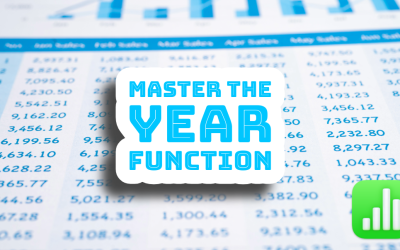When you’re working with dates in Numbers, sometimes you just need to isolate the year. Whether you’re sorting financial data, creating a calendar, or managing long-term projects, being able to quickly extract the year from a date can save a lot of time and effort....
Mastering the DATE Function in Apple Numbers: A Simple Tool for Complex Date Calculations
If you’ve ever had to work with dates in Numbers, you’ve probably realized that manually entering them can get tedious—especially when you’re dealing with dynamic datasets that require flexibility. Fortunately, Numbers has a handy tool that can take care of this for...
Mastering EOMONTH in Apple Numbers: A Handy Tool for Date Calculations
If you’ve worked with dates in Numbers, you know it can be tricky to manage different months and year changes, especially when you’re calculating financials or organizing projects with due dates. That’s where the EOMONTH function comes in handy. It’s one of those...
Mastering the IFERROR Function in Apple Numbers: Handle Errors with Ease
The IFERROR function in Numbers is an incredibly useful tool that allows you to handle errors in your formulas gracefully. When working with large datasets or complex calculations, errors can occur for various reasons—missing data, invalid references, or incorrect...
Mastering the SUMIFS Function in Apple Numbers: Summing Data with Multiple Conditions
The SUMIFS function in Apple Numbers takes data analysis to the next level by allowing you to sum values based on multiple criteria. If you’re working with large datasets or need to filter data by several conditions, SUMIFS is the tool that can help you analyze your...
Understanding the Difference Between a Formula and a Function in Spreadsheet Software
Spreadsheet Function vs Formula If you’ve ever used spreadsheet software like Excel, Google Sheets, or Apple’s Numbers, you’ve likely encountered terms like formula and function. While these terms are often used interchangeably, they have distinct meanings....
Mastering Budget Tracking in Apple Numbers: Adding Categories and Customizations
This article is the second in a series about Mastering Budget Tracking in Numbers Read the first article here: Select How to Create a Simple Budget Template in Apple Numbers: A Beginner’s Guide How to Create a Simple Budget Template in Apple Numbers: A Beginner’s...
Mastering the SUMIF Function in Apple Numbers: Conditional Summing Made Easy
The SUMIF function in Apple Numbers is one of the most powerful tools for working with conditional data. It allows you to sum up values in a range based on a condition or criteria that you specify. Whether you’re calculating sales totals for a specific product,...
How to Determine the Best Chart Type Based on Your Data
When it comes to data visualization, it’s easy to get caught up in choosing flashy charts or using the latest trends. However, at its core, creating charts is about one simple goal: answering a question about your data. If your chart doesn’t answer a clear, relevant...










